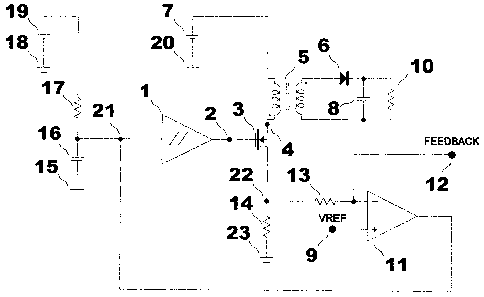Une partie des informations de ce site Web a été fournie par des sources externes. Le gouvernement du Canada n'assume aucune responsabilité concernant la précision, l'actualité ou la fiabilité des informations fournies par les sources externes. Les utilisateurs qui désirent employer cette information devraient consulter directement la source des informations. Le contenu fourni par les sources externes n'est pas assujetti aux exigences sur les langues officielles, la protection des renseignements personnels et l'accessibilité.
L'apparition de différences dans le texte et l'image des Revendications et de l'Abrégé dépend du moment auquel le document est publié. Les textes des Revendications et de l'Abrégé sont affichés :
| (12) Demande de brevet: | (11) CA 2567462 |
|---|---|
| (54) Titre français: | CONVERTISSEUR DE POINTE |
| (54) Titre anglais: | SPIKE CONVERTER |
| Statut: | Réputée abandonnée et au-delà du délai pour le rétablissement - en attente de la réponse à l’avis de communication rejetée |
| (51) Classification internationale des brevets (CIB): |
|
|---|---|
| (72) Inventeurs : |
|
| (73) Titulaires : |
|
| (71) Demandeurs : |
|
| (74) Agent: | |
| (74) Co-agent: | |
| (45) Délivré: | |
| (22) Date de dépôt: | 2006-11-08 |
| (41) Mise à la disponibilité du public: | 2008-05-08 |
| Licence disponible: | S.O. |
| Cédé au domaine public: | S.O. |
| (25) Langue des documents déposés: | Anglais |
| Traité de coopération en matière de brevets (PCT): | Non |
|---|
| (30) Données de priorité de la demande: | S.O. |
|---|
The present invention is a spike converter providing a special mode of
operation of a low power fly-back
converter in a very narrow duty cycle range in particular. This spike
operation minimizes the size of the
required reactive components such as that of the power transformer and output
capacitance. The present
invention automatically achieves low idle power consumption due to the nature
of the feedback under
fixed, narrow duty cycle or spike operation. The spike operation is defined by
the lower limit of the on time
of the switching element being generated by the sum of the propagation delays
of a current sense
comparator and an off time pulse generating comparator.
Note : Les revendications sont présentées dans la langue officielle dans laquelle elles ont été soumises.
Note : Les descriptions sont présentées dans la langue officielle dans laquelle elles ont été soumises.

2024-08-01 : Dans le cadre de la transition vers les Brevets de nouvelle génération (BNG), la base de données sur les brevets canadiens (BDBC) contient désormais un Historique d'événement plus détaillé, qui reproduit le Journal des événements de notre nouvelle solution interne.
Veuillez noter que les événements débutant par « Inactive : » se réfèrent à des événements qui ne sont plus utilisés dans notre nouvelle solution interne.
Pour une meilleure compréhension de l'état de la demande ou brevet qui figure sur cette page, la rubrique Mise en garde , et les descriptions de Brevet , Historique d'événement , Taxes périodiques et Historique des paiements devraient être consultées.
| Description | Date |
|---|---|
| Le délai pour l'annulation est expiré | 2012-11-08 |
| Demande non rétablie avant l'échéance | 2012-11-08 |
| Inactive : Demande ad hoc documentée | 2012-08-10 |
| Inactive : Abandon.-RE+surtaxe impayées-Corr envoyée | 2011-11-08 |
| Réputée abandonnée - omission de répondre à un avis sur les taxes pour le maintien en état | 2011-11-08 |
| Requête pour le changement d'adresse ou de mode de correspondance reçue | 2009-02-06 |
| Demande publiée (accessible au public) | 2008-05-08 |
| Inactive : Page couverture publiée | 2008-05-07 |
| Inactive : CIB attribuée | 2007-02-14 |
| Inactive : CIB en 1re position | 2007-02-14 |
| Inactive : CIB attribuée | 2007-02-14 |
| Exigences de dépôt - jugé conforme | 2006-12-19 |
| Inactive : Certificat de dépôt - Sans RE (Anglais) | 2006-12-19 |
| Demande reçue - nationale ordinaire | 2006-12-12 |
| Déclaration du statut de petite entité jugée conforme | 2006-11-08 |
| Date d'abandonnement | Raison | Date de rétablissement |
|---|---|---|
| 2011-11-08 |
Le dernier paiement a été reçu le 2010-11-08
Avis : Si le paiement en totalité n'a pas été reçu au plus tard à la date indiquée, une taxe supplémentaire peut être imposée, soit une des taxes suivantes :
Veuillez vous référer à la page web des taxes sur les brevets de l'OPIC pour voir tous les montants actuels des taxes.
| Type de taxes | Anniversaire | Échéance | Date payée |
|---|---|---|---|
| Taxe pour le dépôt - petite | 2006-11-08 | ||
| TM (demande, 2e anniv.) - petite | 02 | 2008-11-10 | 2008-09-29 |
| TM (demande, 3e anniv.) - petite | 03 | 2009-11-09 | 2009-10-07 |
| TM (demande, 4e anniv.) - petite | 04 | 2010-11-08 | 2010-11-08 |
Les titulaires actuels et antérieures au dossier sont affichés en ordre alphabétique.
| Titulaires actuels au dossier |
|---|
| IVAN MESZLENYI |
| Titulaires antérieures au dossier |
|---|
| S.O. |